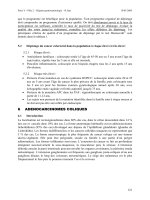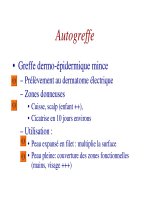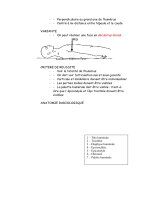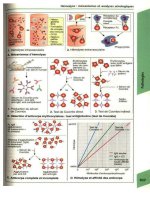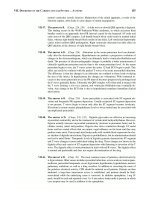BASIC HUMAN ANATOMY - PART 5 pot
Bạn đang xem bản rút gọn của tài liệu. Xem và tải ngay bản đầy đủ của tài liệu tại đây (184.47 KB, 23 trang )
MD0006 6-2
LESSON 6
THE HUMAN DIGESTIVE SYSTEM
Section I. INTRODUCTION
6-1. GENERAL
a. Definition. The human digestive system is a group of organs designed to
take in foods, initially process foods, digest the foods, and eliminate unused materials of
food items. It is a hollow tubular system from one end of the body to the other end.
See figure 6-1.
Figure 6-1. The human digestive system.
MD0006 6-3
b. Major Organs. The major organs involved in the human digestive system
are listed below. They are each discussed later in this lesson.
(1) Mouth or oral complex.
(2) Pharynx.
(3) Esophagus.
(4) Stomach.
(5) Small intestines and associated glands.
(6) Large intestines.
(7) Rectum.
(8) Anal canal and anus.
c. Digestive Enzymes. A catalyst is a substance that accelerates (speeds up)
a chemical reaction without being permanently changed or consumed itself. A digestive
enzyme serves as a catalyst, aiding in digestion. Digestion is a chemical process by
which food is converted into simpler substances that can be absorbed or assimilated by
the body. Enzymes are manufactured in the salivary glands of the mouth, in the lining
of the stomach, in the pancreas, and in the walls of the small intestine.
6-2. FOODS AND FOODSTUFFS
Examples of food items are a piece of bread, a pork chop, and a tomato. Food
items contain varying proportions of foodstuffs. Foodstuffs are the classes of chemical
compounds which make up food items. The three major types of foodstuffs are
carbohydrates, lipids (fats and oils), and proteins. Food items also contain water,
minerals, and vitamins.
Section II. THE SUPRAGASTRIC STRUCTURES
6-3. ORAL COMPLEX
The oral complex consists of the structures commonly known together as the
mouth. It takes in and initially processes food items. See figure 6-2.
MD0006 6-4
Figure 6-2. Anatomy of the oral complex.
a. Teeth.
(1) A tooth (figure 6-3) has two main parts the crown and the root. A root
canal passes up through the central part of the tooth. The root is suspended within a
socket (called the alveolus) of one of the jaws of the mouth. The crown extends up
above the surface of the jaw. The root and inner part of the crown are made of a
substance called dentin. The outer portion of the crown is covered with a substance
known as enamel. Enamel is the hardest substance of the human body. The nerves
and blood vessels of the tooth pass up into the root canal from the jaw substance.
Figure 6-3. Section of a tooth and jaw.
MD0006 6-5
(2) There are two kinds of teeth anterior and posterior. The anterior teeth
are also known as incisors and canine teeth. The anterior teeth serve as choppers.
They chop off mouth-size bites of food items. The posterior teeth are called molars.
They are grinders. They increase the surface area of food materials by breaking them
into smaller and smaller particles.
(3) Humans have two sets of teeth deciduous and permanent. Initially, the
deciduous set includes 20 baby teeth.
DECIDUOUS = to be shed
These are eventually replaced by a permanent set of 32.
b. Jaws. There are two jaws the upper and the lower. The upper is called the
maxilla. The lower is called the mandible.
(1) In each jaw, there are sockets for the teeth. These sockets are known as
alveoli. The bony parts of the jaws holding the teeth are known as alveolar ridges.
(2) The upper jaw is fixed to the base of the cranium.
The lower jaw is movable. There is a special articulation (T-MJ temporo-mandibular
joint) with muscles to bring the upper and lower teeth together to perform their functions.
c. Palate. The palate serves as the roof of the mouth and the floor of the nasal
chamber above. Since the anterior two-thirds is bony, it is called the hard palate. The
posterior one-third is musculo-membranous and is called the soft palate. The soft
palate serves as a trap door to close off the upper respiratory passageway during
swallowing.
d. Lips and Cheeks. The oral cavity is closed by a fleshy structure around the
opening. Forming the opening are the lips. On the sides are the cheeks.
e. Tongue. The tongue is a muscular organ. The tongue is capable of internal
movement to shape its body. It is moved as a whole by muscles outside the tongue.
Interaction between the tongue and cheeks keeps the food between the molar teeth
during the chewing process. When the food is properly processed, the tongue also
initiates the swallowing process.
f. Salivary Glands. Digestion is a chemical process which takes place at the
wet surfaces of food materials. The chewing process has greatly increased the surface
area available. The surfaces are wetted by saliva produced by glands in the oral cavity.
Of these glands, three pairs are known as the salivary glands proper.
g. Taste Buds. Associated with the tongue and the back of the mouth are
special clumps of cells known as taste buds. These taste buds literally taste the food.
That is, they check its quality and acceptability.
MD0006 6-6
6-4. PHARYNX
The pharynx (pronounced "FAIR -inks") is a continuation of the rear of the mouth
region, just anterior to the vertebral column (spine). It is a common passageway for
both the respiratory and digestive systems.
6-5. ESOPHAGUS
The esophagus is a muscular, tubular structure extending from the pharynx,
down through the neck and the thorax (chest), and to the stomach. During swallowing,
the esophagus serves as a passageway for the food from the pharynx to the stomach.
Section III. THE STOMACH
6-6. STORAGE FUNCTION
The stomach is a sac-like enlargement of the digestive tract specialized for the
storage of food. Since food is stored, a person does not have to eat continuously all
day. One is freed to do other things. The presence of valves at each end prevents the
stored food from leaving the stomach before it is ready. The pyloric valve prevents the
food from going further. The inner lining of the stomach is in folds to allow expansion.
6-7. DIGESTIVE FUNCTION
a. While the food is in the stomach, the digestive processes are initiated by
juices from the wall of the stomach. The musculature of the walls thoroughly mixes the
food and juices while the food is being held in the stomach. In fact, the stomach has an
extra layer of muscle fibers for this purpose.
b. When the pyloric valve of the stomach opens, a portion of the stomach
contents moves into the small intestine.
Section IV. THE SMALL INTESTINES AND ASSOCIATED GLANDS
6-8. GENERAL
a. Digestion is a chemical process. This process is facilitated by special
chemicals called digestive enzymes. The end products of digestion are absorbed
through the wall of the gut into the blood vessels. These end products are then
distributed to body parts that need them for growth, repair, or energy.
MD0006 6-7
b. There are associated glands the liver and the pancreas which produce
additional enzymes to further the process.
c. Most digestion and absorption takes place in the small intestines.
6-9. ANATOMY OF THE SMALL INTESTINES
a. The small intestines are classically divided into three areas the duodenum,
the jejunum, and the ileum. The duodenum is C-shaped, about 10 inches long in the
adult. The duodenum is looped around the pancreas.
DUODENUM = 12 fingers (length equal to width of 12 fingers)
The jejunum is approximately eight feet long and connects the duodenum and ileum.
The ileum is about 12 feet long. The jejunum and ileum are attached to the rear wall of
the abdomen with a membrane called a mesentery. This membrane allows mobility and
serves as a passageway for nerves and vessels (NAVL) to the small intestines.
JEJUNUM = empty
ILEUM = lying next to the ilium (bone of the pelvic girdle; PELVIS = basin)
b. The small intestine is tubular. It has muscular walls which produce a
wave-like motion called peristalsis moving the contents along. The small intestine is
just the right length to allow the processes of digestion and absorption to take place
completely.
c. The inner surface of the small intestine is NOT smooth like the inside of new
plumbing pipes. Rather, the inner surface has folds (plicae). On the surface of these
plicae are finger-like projections called villi (villus, singular). This folding and the
presence of villi increase the surface area available for absorption.
6-10. LIVER AND GALLBLADDER
a. Liver Anatomy. The liver is a large and complex organ. Most of its mass is
on the right side of the body and within the lower portion of the rib cage. Its upper
surface is in contact with the diaphragm.
b. Liver Functions. The liver is a complex chemical factory with many
functions. These include aspects of carbohydrate, protein, lipid, and vitamin
metabolism and processes related to blood clotting and red blood cell destruction. Its
digestive function is to produce a fluid called bile or gall.
c. Gallbladder. Until needed, the bile is stored and concentrated in the
gallbladder, a sac on the inferior surface of the liver. Fluid from the gallbladder flows
through the cystic duct, which joins the common hepatic duct from the liver to form the
MD0006 6-8
common bile duct. The common bile duct then usually joins with the duct of the
pancreas as the fluid enters the duodenum.
6-11. PANCREAS
The pancreas is a soft, pliable organ stretched across the posterior wall of the
abdomen. When called upon, it secretes its powerful digestive fluid, known as
pancreatic juice, into the duodenum. Its duct joins the common bile duct.
Section V. THE LARGE INTESTINES
6-12. GENERAL FUNCTION
The primary function of the large intestines is the salvaging of water and
electrolytes (salts). Most of the end products of digestion have already been absorbed
in the small intestines. Within the large intestines, the contents are first a watery fluid.
Thus, the large intestines are important in the conservation of water for use by the body.
The large intestines remove water until a nearly solid mass is formed before defecation,
the evacuation of feces.
6-13. MAJOR SUBDIVISIONS
The major subdivisions of the large intestines are the cecum (with vermiform or
"worm-shaped" appendix), the ascending colon, the transverse colon, the descending
colon, and the sigmoid colon. The fecal mass is stored in the sigmoid colon until
passed into the rectum.
6-14. RECTUM, ANAL CANAL, AND ANUS
Rectum means "straight." However, this six-inch tubular structure would actually
look a bit wave-like from the front. From the side, one would see that it was curved to
conform the sacrum (at the lower end of the spinal column). The final storage of feces
is in the rectum. The rectum terminates in the narrow anal canal, which is about one
and one-half inches long in the adult. At the end of the anal canal is the opening called
the anus. Muscles called the anal sphincters aid in the retention of feces until
defecation.
MD0006 6-9
Section VI. ASSOCIATED PROTECTIVE STRUCTURES
6-15. GENERAL
Within the body, there are many structures that aid in protection from bacteria,
viruses, and other foreign substances. These structures include cells that can
phagocytize (engulf) foreign particles or manufacture antibodies (which help to
inactivate foreign substances). Collectively, such cells make up the reticuloendothelial
system (RES). Such cells are found in bone marrow, the spleen, the liver, and lymph
nodes.
6-16. STRUCTURES WITHIN THE DIGESTIVE SYSTEM
Lymphoid structures make up the largest part of the RES. Lymphoid structures
are collections of cells associated with circulatory systems (to be discussed in lesson 9).
a. Tonsils are associated with the posterior portions of the respiratory and
digestive areas in the head, primarily in the region of the pharynx. The tonsils are
masses of lymphoid tissue.
b. Other lymphoid aggregations are found in the walls of the small intestines.
c. The vermiform appendix, attached to the cecum of the large intestine, is also
a mass of lymphoid tissue. It is the "tonsil" of the intestines.
Continue with Exercises
MD0006 6-11
4. The anterior teeth, called incisors and canine teeth, serve as .
The posterior teeth, called molars, serve as .
5. The palate serves as the roof of the and the floor of the
. The soft palate serves as a to close off
the upper respiratory passageway during swallowing.
6. The tongue aids in and .
7. The pharynx is a common passageway for both the and
systems.
8. The esophagus serves as a passageway for food from the to the
.
9. What is the stomach?
10. The process of digestion is facilitated by special chemicals called
. Most digestion and absorption take place in
the .
11. In order after the stomach, the three areas of the small intestines are the
, the , and the . The jejunum and ileum are
attached to the rear wall of the abdomen with a membrane called the .
12. Folds on the inner surfaces of the small intestines are known as
. Finger-like projections from these folds are known as
.
13. The digestive function of the liver is to produce a fluid called .
The common bile duct joins with the duct of the pancreas as the fluid enters the
.
MD0006 6-12
14. The texture of the pancreas is and .
Pertaining to location, the pancreas is stretched across the ______________ of the
abdomen.
15. The primary function of the large intestine is to water and
electrolytes. The large intestines remove water until a nearly solid mass is formed
before .
16. In order, the major subdivisions of the large intestines are the
, the colon, the colon,
the colon, and the colon.
17. The rectum terminates in the narrow , at the end
of which is an opening called the . Muscles called
aid in the retention of feces until defecation.
18. Attached to the cecum is a mass of lymphoid tissue called the
.
Check Your Answers on Next Page
MD0006 6-13
SOLUTIONS TO EXERCISES, LESSON 6
1. The human digestive system is a group of organs designed to take in foods,
initially process foods, digest the foods, and eliminate unused materials of food
items. It is a hollow tubular system from one end of the body to the other end.
(para 6-1a)
2. Six major organs of the human digestive system are the:
a. Mouth (oral complex).
b. Pharynx.
c. Esophagus.
d. Stomach.
e. Small intestines.
f. Large intestines. (para 6-1b)
3. Seven important structures associated with the oral cavity are the:
a. Teeth.
b. Jaws (maxilla and mandible).
c. Palate.
d. Lips and cheeks.
e. Tongue.
f. Salivary glands.
g. Taste buds. (para 6-3)
4. The anterior teeth, called incisors and canine teeth, serve as choppers. The
posterior teeth, called molars, serve as grinders. (para 6-3a(2))
5. The palate serves as the roof of the mouth and the floor of the nasal chamber.
The soft palate serves as a trap door to close off the respiratory passageway
during swallowing. (para 6-3c)
6. The tongue aids in chewing and swallowing. (para 6-3e)
7. The pharynx is a common passageway for both the respiratory and digestive
systems. (para 6-4)
8. The esophagus serves as a passageway for food from the pharynx to the
stomach. (para 6-5)
9. The stomach is a sac-like enlargement of the digestive tract specialized for the
storage of food. (para 6-6)
MD0006 6-14
10. The process of digestion is facilitated by special chemicals called digestive
enzymes. Most digestion and absorption take place in the small intestines.
(paras 6-8a, c)
11. In order after the stomach, the three areas of the small intestines are the
duodenum, the jejunum, and the ileum. The jejunum and the ileum are attached to
the rear wall of the abdomen with a membrane called the mesentery. (para 6-9a)
12. Folds on the inner surfaces of the small intestines are known as plicae.
Finger-like projections from these folds are known as villi. (para 6-9c)
13. The digestive function of the liver is to produce a fluid called bile (gall). The
common bile duct joins with the duct of the pancreas as the fluid enters the
duodenum. (para 6-10)
14. The texture of the pancreas is soft and pliable. Pertaining to location, the
pancreas is stretched across the posterior wall of the abdomen. (para 6-11)
15. The primary function of the large intestine is to salvage water and electrolytes.
The large intestines remove water until a nearly solid mass is formed before
defecation. (para 6-12)
16. In order, the major subdivisions of the large intestines are the cecum, the
ascending colon, the transverse colon, the descending colon, and the sigmoid
colon. (para 6-13)
17. The rectum terminates in the narrow anal canal, at the end of which is an opening
called the anus. Muscles called anal sphincters aid in the retention of feces until
defecation. (para 6-14)
18. Attached to the cecum is a mass of lymphoid tissue called the vermiform
appendix. (para 6-16c)
End of Lesson 6
MD0006 7-1
LESSON ASSIGNMENT
LESSON 7 The Human Respiratory System and Breathing.
TEXT ASSIGNMENT Paragraphs 7-1 through 7-8.
LESSON OBJECTIVES After completing this lesson, you should be able to:
7-1. Define respiration, external respiration, internal
respiration, and breathing.
7-2. Identify the main subdivisions of the respiratory
system and their functions.
7-3. Describe the external nose, nasal chambers,
pharynx, larynx, trachea, bronchi, alveoli, lungs,
and pleural cavities.
7-4. Describe breathing and breathing mechanisms.
SUGGESTION After completing the assignment, complete the
exercises at the end of this lesson. These exercises
will help you to achieve the lesson objectives.
MD0006 7-2
LESSON 7
THE HUMAN RESPIRATORY SYSTEM AND BREATHING
Section I. THE RESPIRATORY SYSTEM
7-1. INTRODUCTION
a. Respiration. Respiration is the exchange of gases between the atmosphere
and the cells of the body. It is a physiological process. There are two types of respira-
tion external and internal. External respiration is the exchange of gases between the
air in the lungs and blood. Internal respiration is the exchange of gases between the
blood and the individual cells of the body.
b. Breathing. Breathing is the process that moves air into and out of the lungs.
It is a mechanical process. There are two types of breathing in humans costal
(thoracic) and diaphragmatic (abdominal). In costal breathing, the major structure
causing the movement of the air is the rib cage. In diaphragmatic breathing, interaction
between the diaphragm and the abdominal wall causes the air to move into and out of
the lungs.
7-2. COMPONENTS AND SUBDIVISIONS OF THE HUMAN RESPIRATORY
SYSTEM
See figure 7-1 for an illustration of the human respiratory system.
a. Components. The components of the human respiratory system consist of
air passageways and two lungs. Air moves from the outside of the body into tiny sacs in
the lungs called alveoli (pronounced al-VE-oh-lie).
b. Main Subdivisions. The main subdivisions of the respiratory system may be
identified by their relationship to the voice box or larynx. Thus, the main subdivisions
are as listed in table 7-1.
MD0006 7-3
Figure 7-1. The human respiratory system.
MD0006 7-5
a. External Nose. The external nose is the portion projecting from the face. It
is supported primarily by cartilages. It has a midline divider called the nasal septum,
which extends from the internal nose. Paired openings (nostrils) lead to paired spaces
(vestibules). Guard hairs in the nostrils filter inflowing air.
b. Nasal Chambers (Internal Nose). Behind each vestibule of the external
nose is a nasal chamber. The two nasal chambers together form the internal nose.
These chambers too are separated by the nasal septum.
(1) Mucoperiosteum. The walls of the nasal chambers are lined with a thick
mucous-type membrane known as the mucoperiosteum. It has a ciliated epithelial
surface and a rich blood supply, which provides warmth and moisture. At times, it may
become quite swollen.
CILIATED = provided with cilia (hairlike projections which move fluids to the rear)
(2) Conchae. The lateral wall of each chamber has three scroll- like
extensions into the nasal chamber which help to increase the surface area exposed to
the inflowing air. These scroll-like extensions are known as conchae.
CONCHA (pronounced KON-kah) = sea shell
CONCHA (singular), CONCHAE (plural)
(3) Olfactory epithelium. The sense of smell is due to special nerve endings
located in the upper areas of the nasal chambers. The epithelium containing the
sensory endings is known as the olfactory epithelium.
(4) Paranasal sinuses. There are air "cells" or cavities in the skull known as
paranasal sinuses. The paranasal sinuses are connected with the nasal chambers and
are lined with the same ciliated mucoperiosteum. Thus, these sinuses are extensions of
the nasal chambers into the skull bones. For this reason, they are known as paranasal
sinuses.
c. Pharynx. The pharynx (FAIR-inks) is the common posterior space for the
respiratory and digestive systems.
(1) Nasopharynx. That portion of the pharynx specifically related to the
respiratory system is the nasopharynx. It is the portion of the pharynx above the soft
palate. The two posterior openings (nares) of the nasal chambers lead into the single
space of the nasopharynx. The auditory (eustachian) tubes also open into the
nasopharynx. The auditory tubes connect the nasopharynx with the middle ears (to
equalize the pressure between the outside and inside of the eardrum). Lying in the
upper posterior wall of the nasopharynx are the pharyngeal tonsils (adenoids). The soft
palate floor of the nasopharynx is a trapdoor which closes off the upper respiratory
passageways during swallowing.
MD0006 7-6
(2) Oropharynx. The portion of the pharynx closely related to the digestive
system is the oropharynx. It is the portion of the pharynx below the soft palate and
above the upper edge of the epiglottis. (The epiglottis is the flap that prevents food from
entering the larynx (discussed below) during swallowing.)
(3) Laryngopharynx. That portion of the pharynx which is common to the
respiratory and digestive systems is the laryngopharynx. It is the portion of the pharynx
below the upper edge of the epiglottis. Thus, the digestive and respiratory systems lead
into it from above and lead off from it below.
7-4. LARYNX
The larynx, also called the Adam's apple or voice box, connects the pharynx with
the trachea. The larynx, located in the anterior neck region, has a box-like shape. See
figure 7-3 for an illustration. Since the voice box of the male becomes larger and
heavier during puberty, the voice deepens. The adult male's voice box tends to be
located lower in the neck; in the female, the larynx remains higher and smaller and the
voice is of a higher pitch.
a. Parts and Spaces. The larynx has a vestibule ("entrance hallway") which
can be covered over by the epiglottis. The glottis itself is the hole between the vocal
cords. Through the glottis, air passes from the vestibule into the main chamber of the
larynx (below the cords) and then into the trachea. The skeleton of the larynx is made
up of a series of cartilages.
b. Muscles. The larynx serves two functions and there are two sets of
muscles one for each function.
(1) One set controls the size of the glottis. Thus, it regulates the volume of
air passing through the trachea.
(2) The other set controls the tension of the vocal cords. Thus, it produces
vibrations of selected frequencies (variations in pitch) of the moving air to be used in the
process of speaking.
MD0006 7-7
Figure 7-3. The larynx.
7-5. INFRALARYNGEAL STRUCTURES
a. Trachea and Bronchi. The respiratory tree (figure 7-4) is the set of tubular
structures which carry the air from the larynx to the alveoli of the lungs. Looking at a
person UPSIDE DOWN, the trachea is the trunk of the tree and the bronchi are the
branches. These tubular parts are held open (made patent) by rings of cartilage. Their
lining is ciliated to remove mucus and other materials that get into the passageway.
MD0006 7-8
Figure 7-4. Infralaryngeal structures ("respiratory tree").
b. Alveoli. The alveoli (alveolus, singular) are tiny spherical (balloon-like) sacs
which are connected to the larger tubes of the lungs by tiny tubes known as alveolar
ducts and bronchioles. The alveoli are so small that there are billions in the adult lungs.
This very small size produces a maximum surface area through which external
respiration takes place. External respiration is the actual exchange of gases between
the air in the alveolar spaces and the adjacent blood capillaries through their walls.
c. Lungs. A lung is an individual organ composed of tubular structures and
alveoli bound together by fibrous connective tissue (FCT). In the human, there are two
lungs right and left. Each lung is supplied by a primary or mainstem bronchus leading
off of the trachea. The right lung is larger in volume than the left lung. The left lung
must leave room for the heart. The right lung is divided into three pulmonary lobes
(upper, middle, and lower) and 10 bronchopulmonary segments (2 + 3 + 5). The left
lung is divided into two pulmonary lobes (upper and lower) and eight bronchopulmonary
segments (4 + 4). A pulmonary lobe is a major subdivision of a lung marked by fissures
(deep folds). Each lobe is further partitioned into bronchopulmonary segments. Each
MD0006 7-9
lobe is supplied by a secondary or lobar bronchus. Each segment is supplied by a
tertiary or segmental bronchus, a branch of the lobar bronchus.
d. Pleural Cavities. See paragraph 3-14 to review a description of pleural cavities.
That paragraph indicates that each serous cavity has inner and outer membranes. In
the case of the lungs, the inner membrane is known as the visceral pleura which very
closely covers the surface of the lungs. The outer membrane is known as the parietal
pleura, forming the outer wall of the cavity. The pleural cavities are the potential spaces
between the inner and outer membranes. The pleural cavities allow the lungs to move
freely with a minimum of friction during the expansion and contraction of breathing.
Section II. BREATHING AND BREATHING MECHANISMS IN HUMANS
7-6. INTRODUCTION
a. Boyle's law tells us that as the volume (V) of a gas-filled container increases,
the pressure (P) inside decreases; as the volume (V) of a closed container decreases,
the pressure (P) inside increases. When two connected spaces of air have different
pressures, the air moves from the space with greater pressure to the one with lesser
pressure. In regard to breathing, we can consider the air pressure around the human
body to be constant. The pressure inside the lungs may be greater or less than the
pressure outside the body. Thus, a greater internal pressure causes air to flow out; a
greater external pressure causes air to flow in.
b. We can compare the human trunk to a hollow cylinder. This cylinder is
divided into upper and lower cavities by the diaphragm. The upper is the thoracic cavity
and is essentially gas-filled. The lower is the abdominopelvic cavity and is essentially
water-filled.
7-7. COSTAL (THORACIC) BREATHING
a. Inhalation. Muscles attached to the thoracic cage raise the rib cage. A
typical rib might be compared to a bucket handle, attached at one end to the sternum
(breastbone) and at the other end to the vertebral column. The "bucket handle" is lifted
by the overall movement upward and outward of the rib cage. These movements
increase the thoracic diameters from right to left (transverse) and from front to back
(A-P). Thus, the intrathoracic volume increases. Recalling Boyle's law, the increase in
volume leads to a decrease in pressure. The air pressure outside the body then forces
air into the lungs and inflates them.
b. Exhalation. The rib cage movements and pressure relationships are
reversed for exhalation. Thus, intrathoracic volume decreases. The intrathoracic
pressure increases and forces air outside the body.
MD0006 7-10
7-8. DIAPHRAGMATIC (ABDOMINAL) BREATHING
The diaphragm is a thin, but strong, dome-shaped muscular membrane that
separates the abdominal and thoracic cavities. The abdominal wall is elastic in nature.
The abdominal cavity is filled with soft, watery tissues.
a. Inhalation. As the diaphragm contracts, the dome flattens and the
diaphragm descends. This increases the depth (vertical diameter) of the thoracic cavity
and thus increases its volume. This decreases air pressure within the thoracic cavity.
The greater air pressure outside the body then forces air into the lungs.
b. Exhalation. As the diaphragm relaxes, the elastic abdominal wall forces the
diaphragm back up by pushing the watery tissues of the abdomen against the underside
of the relaxed diaphragm. The dome extends upward. The process of inhalation is thus
reversed.
Continue with Exercises
MD0006 7-12
9. The functions of the supralaryngeal structures are to c ,
w , m , and t inflowing air.
10. The functions of the larynx are to control the of the
inflowing air and to produce selected ( ).
11. The function of the infralaryngeal structures is to distribute air to the
of the . Here, actual external respiration takes place.
12. The external nose is supported primarily by .
13. The two nasal chambers are separated by the . The walls of
the nasal chambers are lined with a membrane known as the .
Scroll-like extensions, which increase the surface area of the lateral walls, are known as
. Sensory endings for the sense of smell are found in the ___________
epithelium. Air "cells" or cavities in the skull are known as .
14. That portion of the pharynx specifically related to the respiratory system is
the . It is the portion of the pharynx above the
.
15. During swallowing, food is prevented from entering the larynx by the
.
16. In the larynx, one set of muscles regulates the volume of air passing through
the trachea by controlling the . Another set of muscles produces selected
frequencies (variations in pitch) by controlling the .
17. The trunk of the respiratory tree is called the .
The branches are called the .
18. What are alveoli?
19. A lung is an individual organ composed of structures and
bound together by tissue.
MD0006 7-13
20. The pleural cavities allow the lungs to move freely with a minimum of
during the expansion and contraction of breathing.
21. In both costal and diaphragmatic breathing, inhalation depends upon an
increase in lung volume. The diameters increased in costal breathing are from
and from . The diameter increased in
diaphragmatic breathing is .
Check Your Answers on Next Page



